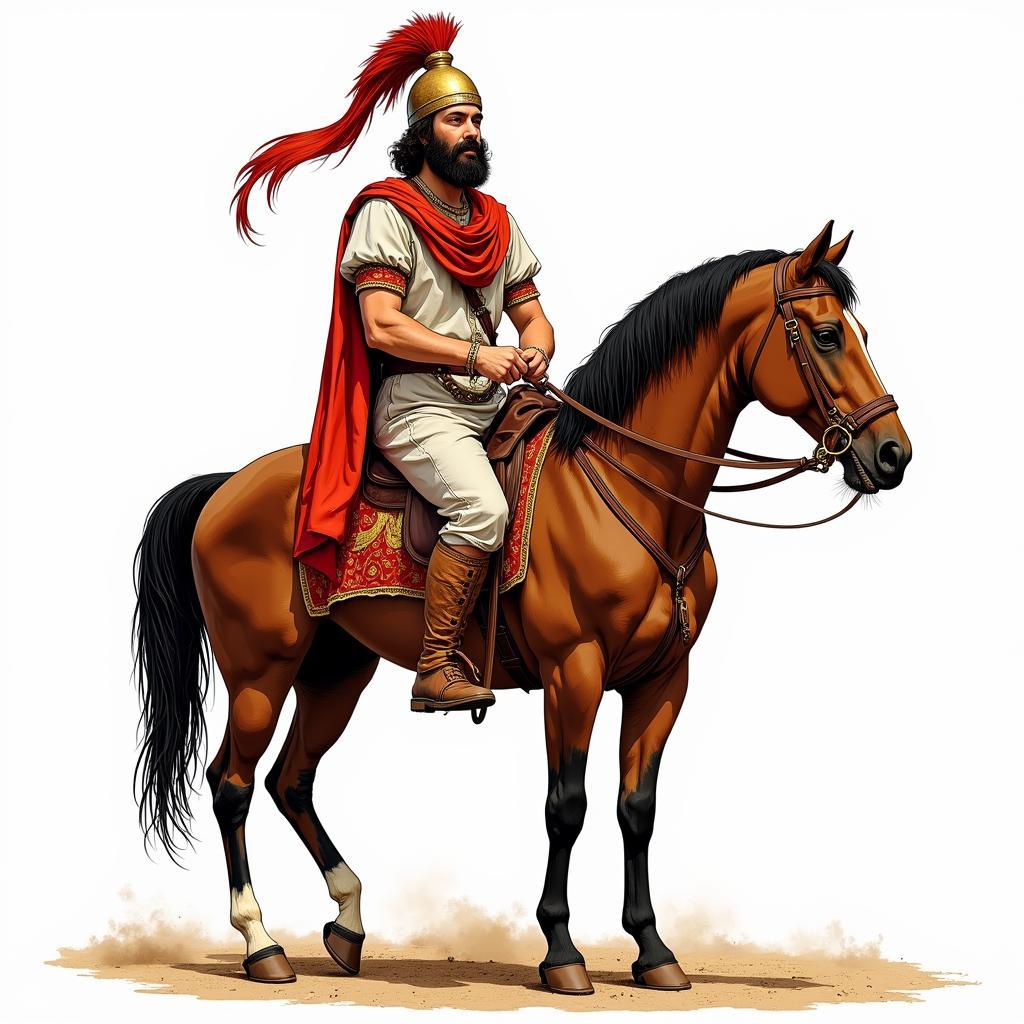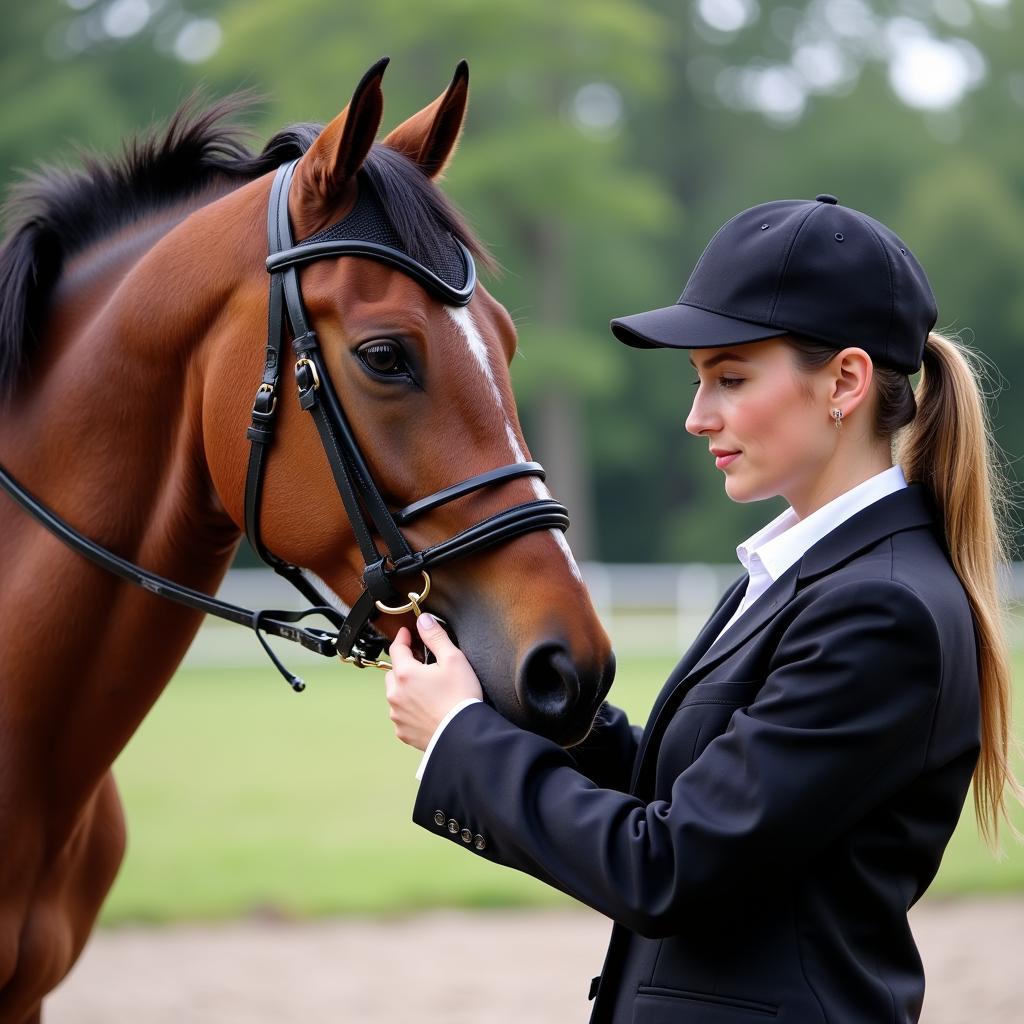The Spanish noseband, also known as the Iberian noseband or Serreta, is a unique and traditional piece of horse tack with origins deeply rooted in the Iberian Peninsula. This noseband stands out for its distinctive design, often featuring intricate hand-stitched details and a craftsmanship that speaks to centuries of equestrian tradition. However, beyond its aesthetic appeal, the Spanish noseband serves a specific purpose in horse training and riding. Let’s delve into the world of the Spanish noseband, exploring its history, functionality, and the considerations for its use.
A Glimpse into History: The Origins of the Spanish Noseband
 Ancient Iberian Horseman Using a Serreta
Ancient Iberian Horseman Using a Serreta
The Spanish noseband’s history can be traced back centuries to the Iberian Peninsula, a region encompassing modern-day Spain and Portugal. Its origins are closely intertwined with the development of traditional Iberian horse breeds, such as the Andalusian, Lusitano, and Alter Real. These breeds, known for their intelligence, sensitivity, and athleticism, played a pivotal role in shaping equestrian practices in the region.
The term “Serreta,” often used interchangeably with “Spanish noseband,” provides a clue to its original purpose. “Serreta” translates to “little saw” in Spanish, hinting at the noseband’s historical use in training young horses. The design, featuring a semi-circular or figure-eight shaped nosepiece often with a chain, was intended to provide clear communication and control during the early stages of training.
Functionality and Purpose: How the Spanish Noseband Works
Unlike other nosebands primarily designed to prevent a horse from opening its mouth excessively, the Spanish noseband focuses on leverage and pressure points. Here’s how it works:
-
Leverage: The design of the Spanish noseband creates leverage points that act on the horse’s head and poll (the area behind the ears). When the reins are engaged, pressure is transferred through the noseband, encouraging the horse to yield at the poll and bring its head into a desired position.
-
Pressure Points: The placement of the noseband, specifically the nosepiece and optional chain, creates pressure points on the bridge of the horse’s nose and under the chin. This pressure, used with sensitive hands, acts as a signal for the horse to respond to the rider’s aids.
-
Communication and Control: The Spanish noseband, when used correctly, can be a valuable tool for communicating with a horse through subtle cues. The pressure and release of the noseband provide clear signals, allowing for refined movements and responses.
Considerations for Use: When and How to Use a Spanish Noseband
 Experienced Rider Using a Spanish Noseband on a Lusitano Horse
Experienced Rider Using a Spanish Noseband on a Lusitano Horse
The Spanish noseband is not a piece of equipment to be used lightly or by inexperienced hands. Its effectiveness relies heavily on the rider’s skill, timing, and understanding of horse behavior.
-
Experience Level: This noseband is generally not recommended for beginners or riders who have not received proper instruction on its use. The leverage and pressure points, if misused, can cause discomfort or pain to the horse.
-
Training Stage: While traditionally used in early training, the Spanish noseband can be a useful tool for experienced riders working with horses at various stages. It can be particularly helpful in refining movements, promoting collection, and addressing specific training challenges.
-
Fit and Adjustment: Proper fit is crucial for any piece of tack, and the Spanish noseband is no exception. It should be adjusted to fit snugly but not too tightly, allowing for proper breathing and avoiding any pinching or discomfort.
-
Sensitivity and Communication: It’s essential to remember that the Spanish noseband should be used with a high level of sensitivity and as a means of communication, not punishment. The goal is to achieve a light, responsive connection with the horse.
Conclusion
The Spanish noseband is a piece of equestrian history that continues to be used today in various disciplines, from classical dressage to working equitation. Its effectiveness lies in its ability to enhance communication and refine movements when used correctly by experienced hands. However, it’s crucial to prioritize the horse’s well-being, ensuring proper fit and using the noseband with sensitivity and understanding.
Need Assistance?
We are dedicated to providing you with the best horse care advice. For any questions or concerns about Spanish nosebands or other equestrian equipment, please contact us:
- Phone: 0772127271
- Email: [email protected]
- Address: QGM2+WX2, Vị Trung, Vị Thuỷ, Hậu Giang, Việt Nam
Our team is available 24/7 to assist you!